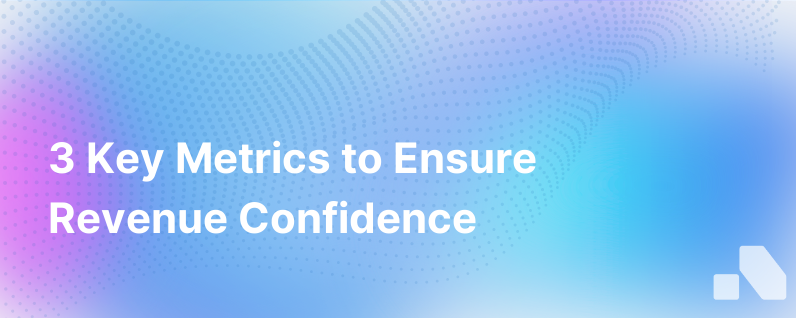
In the burgeoning world of B2B sales, understanding and tracking the right metrics can be the difference between a company that thrives and one that merely survives. Revenue confidence, unlike many other financial forecasts, looks beyond the spreadsheets to assess the real-world viability of a company's revenue-generation strategy.
To establish revenue confidence, there are three pivotal metrics that organizations should closely monitor: Customer Lifetime Value (CLV), Sales Cycle Length, and Win Rate. Incorporating these metrics into regular analyses can offer companies enduring insights into their sales strategy's potential and provide a more reliable snapshot of future financial health. Let’s take a closer look at each metric independently.
1. Customer Lifetime Value (CLV)
Understanding the Customer Lifetime Value (CLV) holds paramount importance in the grand scheme of B2B sales. Essentially, CLV measures the total revenue a business can expect from a single customer account throughout their relationship with the company. It is a projection that compiles the cumulative purchasing power of a client over the duration of their engagement.
The formula to ascertain CLV is relatively straightforward and is given by:
CLV = Average Value of a Sale x Number of Repeat Transactions x Average Retention Time
This figure enables companies to discern the worth of investing in customer retention efforts versus solely focusing on acquisition. A high CLV is significant; it suggests that your clients remain with your business for long periods and continue to contribute substantial revenue over time.
Focusing on strategies that elevate CLV, such as account-based marketing, personalized customer success initiatives, and staggered upselling, can lead to sustained revenue. Companies can more accurately predict income streams from existing customer bases, ensuring revenue stability and allowing for more aggressive growth strategies. Moreover, CLV variation trends can indicate the efficiency and effectiveness of customer service processes, product value propositions, and pricing strategies.
2. Sales Cycle Length
The Sales Cycle Length is another pivotal metric, providing a clear lens through which the efficiency and effectiveness of the sales funnel can be viewed. It measures the average amount of time taken from a potential customer's first point of contact with the company until a deal is closed.
Calculating the Sales Cycle Length involves an examination of timestamps across multiple sales in a given period and then determining the average:
Sales Cycle Length = Sum of Sales Cycle Lengths for All Deals / Number of Closed Deals
Monitoring this metric is vital for a few reasons. Firstly, a shorter sales cycle generally means more efficient sales processes, allowing for less time and resource expenditure per sale. Secondly, it signifies that the company’s value proposition is resonating swiftly and strongly with prospects. Lastly, it clarifies revenue forecasting, as predictable sales cycle lengths allow you to project future income with greater accuracy.
Sales cycle analysis can inspire actions like refining sales collateral, implementing targeted sales training, or leveraging sales acceleration tools -- all aimed at cutting down the time to conversion.
3. Win Rate
Win Rate underscores the effectiveness of a sales team by illustrating what percentage of opportunities convert into customers. It is the quantifiable success rate out of all prospects a company engages with, gauging the competitiveness and market suitability of a company's offerings.
The Win Rate is computed by examining the number of won opportunities versus the total number of opportunities:
Win Rate = (Number of Won Opportunities / Total Number of Opportunities) x 100
A high Win Rate instills confidence in a company’s revenue predictability. It indicates solid market fit, competitive advantage, and proficiency in handling sales conversations. Conversely, a low or declining win rate might signal various issues such as product-market misalignment, ineffective sales strategies, or aggressive competition.
Tracking Win Rate can lead to strategic changes in sales approaches, product development pivots, or market repositioning with the goal of aligning the company more closely with the demands of its target audience.
Besides the core calculation, it's critical to delve into different sales channels, product lines, and customer segments to gather nuanced insights and inspire targeted interventions.
Creating Revenue Confidence with Robust Analysis
A harmonious relationship between CLV, Sales Cycle Length, and Win Rate can cultivate robust revenue confidence within an organization. Pairing these metrics with a dynamic CRM where real-time analysis unfolds can have a transformative effect on a company's financial trajectory.
Strategic tool implementation, like Aomni, can empower a company to conduct this analysis continuously, ensuring that decisions are made on the freshest data available. This can bring actionable insights to the forefront of conversations, drive sales strategy, and ultimately boost financial confidence.
Closing Thoughts
By rigorously monitoring these three metrics—CLV, Sales Cycle Length, and Win Rate—business leaders can nurture an environment where revenue growth is based on data-driven confidence rather than speculation. This combined approach provides a comprehensive gauge of a company’s health and its future revenue generation ability, thereby equipping it with the means to not just envision but confidently execute a sustainable growth strategy.